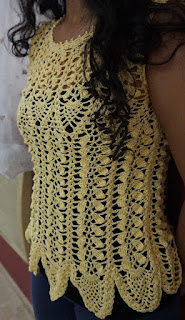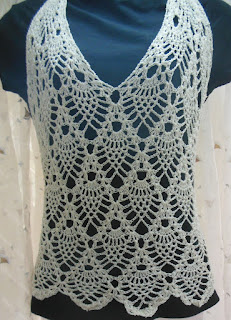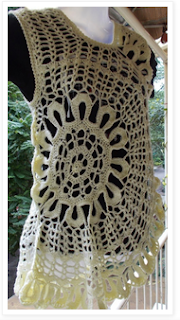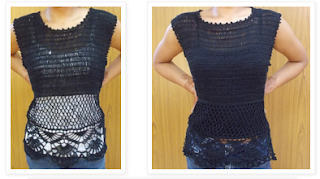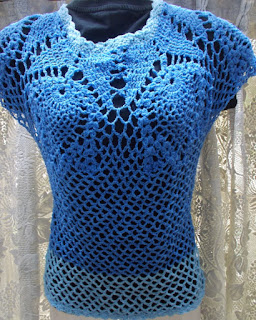UNE FLEUR - FLOWER LIKE LADIES TOP
Yet another superb pattern that was shared by
the lovely +Clara Isabel and with this really superb DMC Petra yarn, I found
something unique that I think will do both this pattern and yarn justice.
I
think this top looks just like a flower, whatchathink?
Thank you for joining me.
In case you have just joined me, know that you can access all of my earlier creations by checking under ‘categories’ on the right hand side of this blog under “Labels”. Then, for your convenience, follow me here or on Facebook, You Tube, Pinterest, Twitter or Instagram.
Check out all my social media handles at the bottom of this blog.
Oh, and may I add that the fastest way to find any of my blogs is via Pinterest.
Do remember to add my blog URL when you make and show off your creation. Cheers. Enjoy
To purchase this or similar yarn online, click on the link at the top right of this blog that reads click here to buy your yarns online via Amazon. While you will still pay the same, I may get paid by Amazon as well. This is a free blog - so do pay it forward for me. Cheers.
The Pinterest link https://in.pinterest.com/pin/470063279834864692/
As I work on this pattern, I’ve
written down my notes that I share with you... and here's the picture that inspired me to work on this superb top.
Materials used : Today I’ve used the superbly soft DMC Petra (5) knitting cotton
yarn, with a 3 mm crochet hook
For Indians : DMC Petra is like our superb Indian H.P Peecock knitting cotton or
a little thinner than our Indian Red Rose or our Anchor knitting cotton in
thickness. With our Red Rose knitting
cotton I’d say that some colours vary in thickness.. I found, for e.g. that the
black is really much thinner than the other colours.
Skill level : Intermediate to Advanced.
The stitches, per se, are not
difficult at all. The combination of
stitches, and the calculations involved though required some Advanced skills.
This is mainly because the chart only gives one basic bit for the yoke, which is
a little difficult to explain. I’ve tried my best, so I do hope you’ll have as
much fun as I am.
Abbreviations used : (Using U.S terminology)
ch : chain ch-sp
: chain space
sp : space rep
: Repeat
dc 3-tog : Double Crochet 3-together
fsc : Foundation single crochet
dc : Double crochet
Stitches used :
Starting slip knot : Here’s how you start with a slip knot. https://youtu.be/lJcqsVcs8cw
Starting slip knot 1 or the Sloppy Slip knot : This is a neat new way to start your work without a slip knot. https://youtu.be/YfC7KmGpifs
What is a slip stitch : Here is a neat video tutorial at https://youtu.be/weB3QNbA8Iw
What is a chain stitch ? Here is an easy video tutorial https://www.youtube.com/watch?v=pXx5ukBjKkY
What is a slip stitch : Here is a neat video tutorial at https://youtu.be/weB3QNbA8Iw
Magic circle : To refresh your skill, please view this easy video https://youtu.be/ISC39yOqWro
Foundation Single Crochet : fsc : To refresh your skill on the fsc, please view this video https://youtu.be/mcT85fwh4mA
Half Double Crochet : Hdc : yo, insert hk into st ; yo (3 lps on hk) ;
yo, draw through all 3 lps. One hdc made.
Check out the video at https://youtu.be/sDiELJdB2Dg
Chainless start for Half Double Crochet : I dislike the ch-2 start, and this is what I do to start my row of hdc. Check out the video at https://youtu.be/lWXpl1KdbZ8
Double Crochet : dc : yo, insert hk into st ; yo (3 lps on hk);
[yo, draw through 2 lps] twice. One dc made.
Check out the video at https://youtu.be/xdnjB27zpYo
Chainless start for Double Crochet : I dislike the ch-2 / ch – 3 start, and this is what I do to start my row of dc.
Check out the video at https://youtu.be/wskv3iTjRx0
Double Triple Crochet : dtrc : wrap yarn three times around hook, insert hk into st ; yo (4 lps on hk); [yo, draw through 2 lps] three times. One trc made.
Check out the video at https://youtu.be/XyPrnAtOs3U
Whipstitch to join : Here’s a quick tutorial on how to join using the whipstitch at https://youtu.be/wZ-9LNzftMA
Invisible join : Here’s a quick tutorial on how to join using the embroidery needle and whipstitch to get an invisible join at https://youtu.be/a6XZQ6VzJFM
Single crochet to join : Here’s a quick tutorial on how to join using the single crochet at https://youtu.be/6FXoW_47_dI
Instructions : (Using U.S terminology)
Please note that I start all my rows with a ch 1, turning chain for ease.
Please check the top of this blog for easy video tutorials on all stitches used in today's pattern.
Please read through all my notes before you pick up your hook, so you know just where we're heading in our pattern.
In my patterns I work with the principle of stitch count and body measurement. This means that you need to work the stitch count in pattern, till you get the measurement (length and/or width) that you need for your project.
Quick analysis of what we’re going
to do here today. Our
pattern starts at the shoulders and we work our way down yoke of the top to the body.
So we will start with one shoulder,
work our way for a few rows down, and then fasten off. We will then work on the second shoulder,
work till the same point as for the first side, and then join up and work in
rows side to side.
This pattern is the same for the
back and front. However, if you wish ,
you could make the back a lot higher than the front, so you will work from Row
1 with the same pattern.
This is the tweak or difference that
will decide your creativity. I am
therefore, going to state that you need to make two front pieces and you decide
if you want this dipped neckline or you want it straight up to the top for the
back.
Our stitch count is in multiples of 20 + 1
FRONT : (Make two)
Start with 21 fsc for one side of your shoulder.
Row 1 : sc in the 1st
fsc ;
(ch 3, sk next 3 fsc, sc in the next fsc) ;
rep (to) once ; ch 5, sk next
3 fsc, sc in the next fsc ;
rep (to) 2 times. Turn.
Row 2 : (dc ; ch 1, 2 dc)
all in the 1st sc ;
ch 3, sk next two ch-3 sps and sc, 3 dc in the
next sc ;
ch 3, dc in the next ch5 sp ; ch 3, 3 dc in the next sc ;
ch 3, sk
next two ch-3 sps and sc, [2 dc, ch 1, dc] all in the last sc. Turn.
Now per this chart, it looks
like we’re working a new stitch.
Do bear
with me as I try to explain this to you.
Arrow-head stitch : This is not the name of this stitch, and I don’t
think such a stitch exists, but this is
what we’re going to refer to this stitch as.
Now usually when we do this
particular arrow-shaped stitch, we work a set of 4 dc in one row, and then on
the following row we will work a dc 4-tog over the 4 dc and make it an
arrow head.
However, in this chart, the
designer has clubbed both of these movements into one.
So this means that you will
first work the 4 dc, TURN
and work the dc 4-tog over the same 4 dc,
turn again and then work in the needed direction for the next stitch.
So remember for this stitch,
that I am calling the Arrow-head stitch, we’re working two rows for this
one stitch.
Our Arrow-head stitch is worked over 3 dc as follows :
{[dc in the next dc ; 2 dc in
the next dc ; dc in the next dc] ;
Turn and work dc 4-tog over the same 4 dc just made
; then Turn again}
Double crochet 4-tog as a decrease stitch : dc 4-tog : Here is an easy video tutorial for working a dc 4-tog over 4 sts at https://youtu.be/WjSNi7ithIU
Double crochet 4-tog as a decorative stitch : dc 4-tog : Here is an easy video tutorial for working a dc 4-tog all in the same stitch as a decorative stitch at https://youtu.be/_B0-ye0cClU
Row 3 : dc in the 1st
dc ;
(ch 1, 2 dc in the next ch-1 sp) ;
ch 2, {[dc in the next dc ; 2
dc in the next dc ; dc in the next dc] ;
Turn and work dc 4-tog
over the same 4 dc just made ; then Turn again} ;
{ch 3, dc in the next dc ; ch
5, dc in the same dc} ;
ch 3, rep {to} once ;
ch 2, sk next 2 dc, 2 dc
in the next ch-1 sp ;
dc in the last dc.
Turn.
Great.. we’ve worked a new
stitch / creation.
Hence forth, we will
call this the Arrow-head stitch and when you read these words, you need
to work the 4 dc first, and then work the dc 4-tog over them, all in one
swoop.
Yaay.. let’s carry on.
Row 4 : dc in the 1st
dc ;
(ch 1, 2 dc in the same ch-1 sp) ;
ch 3, sk Arrow-head st, 3
dc in the next dc ;
ch3, dc in the next ch-3 sp ;
ch 3, 3 dc in the next dc ;
ch 3, sk Arrow-head st , 2 dc in the next ch-1 sp ;
ch 1, dc in the last
dc. Turn.
The following row has our new
Arrow head stitch again.
Remember it's
two rows in one.
This is our neckline edge.
Row 5 : dc in the 1st
dc ; dc in the next ch-1 sp ;
(ch 1, 2 dc in the same ch-1 sp) ;
ch 2,
work the Arrow-head st over the next 3 dc ;
ch 3, dc in the next dc ; ch
5, dc in the same dc ;
ch 3, work the Arrow-head st over the next
3 dc ;
ch 2, 2 dc in the next ch-1 sp ; ch 1, dc in the last dc. Turn.
From this row on, we’ll use a
“V”-st. Our “V”-st for this pattern will
be
( 2 dc ; ch 2, 2 dc ) all in the same ch-sp.
Row 6 : dc in the 1st
dc ;
(ch 1, 2 dc in the same ch-1 sp) ;
ch 3, sk Arrow-head st, 3
dc in the next dc ;
ch 3, dc in the next ch-3 sp ; ch 3, 3 dc in the next dc ;
ch 3, sk Arrow-head st , “V”-st in the last “V”-st ;
ch 3, dc in the
last dc.
Ch 51 and fasten off, leaving a
small tail for attachment.
We’ve completed one side of the shoulder and the ch-51 will be the ch that goes across the top of the chest.
Now, our pattern repeat remains 20, but the extra
sts are for either side of the neckline.
As stated before, I am unable
to write a proper stitch count repeat as its given only for one size, which
seems to be right for me. I am, however,
assuming that if it does not work for you, (i.e if you think ch 51 is
insufficient for the neckline), then add 20 sts to it which is one stitch count
repeat, and it should work.
Right then. Start with the fsc
once again and work Rows 1 – 6 for the other side of the shoulder to neckline.
Remember you are doing a mirror
image, so if you are particular about the wrong and right side of your
work, you will need to mirror the instructions for Rows 5 and 6. (i.e ensure
you get the armhole and neckline sides right, as there are extra stitches only
for the neckline side)
Once you’ve done both the
shoulders – till Row 6, join the ch-51 to the end of the dc of Row 6 of second side just
done.
Fasten off and re-fasten your
yarn to the armhole end of Row 6.
We will now work in continuous
rows from side to side (i.e armhole to armhole).
Note for back : These are
instructions for the Front of your top.
If you wish to do the same for the back with a deep neck, then great,
you follow instructions exactly. If not,
then you will start with the pattern repeat for back and work the pattern all
the way from the shoulder down – attaching the shoulders for front and back as
usual.
In the following row, we will
work on the stitches of one side of the shoulder, and then we will work on the
51 chain made, and then the stitches on the other side of the shoulder. For convenience, I will call all of the
chains in this 51-ch sp “stitches” or sts.
Row 7 : dc in the 1st
dc ; ch 1, 2 dc in the same ch-1 sp ;
{ch 2, work the Arrow-head st
over the next 3 dc ;
ch 3, dc in the next dc ; ch 5, dc in the same dc ;
ch 3, work the Arrow-head st over the next 3 dc} ;
ch 2, “V”-st in the next “V”-st
;
ch 2, work “Arrow-head st” over the next 3 sts ;
[ch 3, sk next 3 sts, dc in the
next sc ;
ch 5, dc in the same st] ;
(ch 3, sk next 3 sts, sc in the
next st) ;
rep (to) 3 times ;
ch 5, sk next 3 sts, sc in the
next st ;
rep (to) 3 times ;
rep [to] once ;
ch 3, sk next 3
sts, work “Arrow-head st” over the next 3 sts ;
ch 2, “V”-st in the next “V”-st
;
rep {to} once ;
ch 2, 2 dc in the last ch-1 sp
;
ch 1, dc in the last dc. Turn.
Row 8 : dc in the 1st
dc ;
(ch 1, 2 dc in the same ch-1 sp) ;
{ch 3, sk Arrow-head st,
3 dc in the next dc ;
ch 3, dc in the next ch-3 sp ; ch 3, 3 dc in the next dc
;
ch 3, sk Arrow-head st ,
“V”-st in the next “V”-st} ;
ch 3, sk next sk Arrow-head st, 3 dc in the
next dc ;
ch 3, dc in the next ch-3 sp ; ch 3, 3 dc in the next dc ;
ch 3, sk next two ch-3 sps and
sc, “V”-st in the next sc ;
ch 3, sk next two ch-2 sps and sc , 3 dc in the
next sc ,
ch 3, dc in the next ch-5 sp ;
ch 3, 3 dc in the next sc ;
ch 3, sk next two ch-3 sps and sc, “V”-st in the
next sc ;
ch 3, sk next two ch-3 sps and sc, 3 dc in the next dc ;
ch 3, dc in
the next ch-5 sp ;
ch 3, 3 dc in the next dc ;
ch 3, “V”-st in the next “V”-st
;
rep {to} once ;
ch 3, 2 dc in the last ch-1 sp ;
ch 1 , dc in the last
dc.
Row 9 : dc in the 1st
dc ;
(ch 1, 2 dc in the same ch-1 sp) ;
{ch 2, work the Arrow-head st
over the next 3 dc ;
ch 3, dc in the next dc ; ch 5, dc in the same dc ;
ch 3, work the Arrow-head st over the next 3 dc} ;
ch 2, “V”-st in the next “V”-st
;
rep {to} 4 times ending with ch 2, 2 dc in the last ch-1 sp ;
ch 1, dc in the
last dc. Turn.
Row 10 : dc in the 1st
dc ;
(ch 1, 2 dc in the same ch-1 sp) ;
{ch 3, sk Arrow-head st,
3 dc in the next dc ;
ch 3, dc in the next ch-5 sp ; ch 3, 3 dc in the next dc
;
ch 3, sk Arrow-head st ,
“V”-st in the next “V”-st} ;
ch 3, sk next two ch-3 sps and sc, “V”-st in the
next sc ;
ch 3, sk next two ch-2 sps and sc , 3 dc in the next sc ;
ch 3, dc in the next ch-5 sp ; ch 3, 3 dc in
the next sc ;
ch 3, sk next two ch-3 sps and sc, “V”-st in the next sc ;
ch 3,
sk next two ch-3 sps and sc, 3 dc in the next dc ;
ch 3, dc in the next ch-5 sp
; ch 3, 3 dc in the next dc ;
ch 3, “V”-st in the next “V”-st ;
rep {to} once ;
ch 3, 2 dc in the last ch-1 sp ;
ch 1 , dc in the last dc.
Row 11 - 12 : Rep Rows 9 and 10
Row 13 : sl-st into the 1st
ch-1 sp ; “V”-st in the same ch-1 sp ;
{ch 2, work the Arrow-head st
over the next 3 dc ;
ch 3, dc in the next dc ; ch 5, dc in the same dc ;
ch 3, work the Arrow-head st over the next 3 dc} ;
ch 2, “V”-st in the next “V”-st
;
rep {to} 4 times ending with “V”-st in the last ch-1 sp. Turn.
Row 14 : “V”-st in the 1st
“V’-st ; ch 2, 2 dc in the same 1st “V”-st ;
*ch 3, sk next
arrow-head st, 9 dc in the next ch-5 sp ;
ch 3, sk next arrow-head st, (“V”-st
in the next “V”-st ;
ch 2, 2 dc in the same “V”-st)* ;
rep *to* till
end. Turn.
Row 15 : “V”-st in the 1st
“V’-st ; “V”-st in the next ch-2 sp ;
*ch 3, sc in the next dc ;
(ch 3,
sk next dc, sc in the next dc) ;
rep (to) 3 times ;
ch 3, “V”-st in the next “V”-st
; “V”-st in the next ch-2 sp* ;
rep *to* till end. Turn.
Row 16 : “V”-st in the 1st
“V”-st ;
ch 2, “V”-st in the next “V”-st ;
*ch 3, sk the next ch-3 sp, sc in
the next ch-3 sp ;
(ch 3, sc in the next ch-3 sp) ;
rep (to) 2 times ;
ch 3,
“V”-st in the next “V”-st ; ch 2, “V”-st in the next “V”-st* ;
rep *to* till
end. Turn.
Row 17 : “V”-st in the 1st
“V”-st ;
ch 3, sc in the next ch-2 sp ; ch 3, “V”-st in the next “V”-st ;
*ch
3, sk the next ch-3 sp, sc in the next ch-3 sp ;
(ch 3, sc in the next ch-3 sp)
;
rep (to) once ;
ch 3, “V”-st in the next “V”-st ;
ch 3, sc in the next ch-2
sp ; ch 3, “V”-st in the next “V”-st* ;
rep *to* till end. Turn.
Row 18 : “V”-st in the 1st
“V”-st ; ch 3, sk next ch-3 sp ,
[dc in the next sc ; ch 3, dc in the same
sc] ;
ch 3, “V”-st in the next “V”-st ;
*ch 3, sk the next ch-3 sp, sc in the
next ch-3 sp ;
(ch 3, sc in the next ch-3 sp) ;
ch 3, “V”-st in the next “V”-st
;
ch 3, sk next ch-3 sp , rep [to] once ;
ch 3, “V”-st in the next “V”-st* ;
rep *to* till end. Turn.
Row 19 : “V”-st in the 1st
“V”-st ;
(ch 2, sc in the next ch-3 sp ;
[ch 1, dc in the next ch-3 sp ; ch 5,
dc in the same ch-3 sp] ;
ch 1, sc in the next ch-3 sp ; ch 2, “V”-st in
the next “V”-st) ;
*ch 3, sk next ch-3 sp, sc in
the next ch-3 sp ;
ch 3, “V”-st in the next “V”-st ;
rep (to) once* ;
rep *to*
till end. Turn.
Row 20 : “V”-st in the 1st
“V”-st ;
(ch 3, 3 dc in the next dc ;
ch 3, dc in the next ch-5 sp ; ch 3, 3 dc
in the next dc) ;
*ch 3, “V”-st in the next
“V”-st ;
sk next two ch-3 sps and sc, “V”-st in the next “V”-st ;
rep (to)
once* ;
rep *to* till end ;
ch 3, “V”-st in the last “V”-st. Turn.
We’ve now completed the yoke
portion of our top and will proceed for the lower repeated portion.
Now for convenience, I’m going
to start renumbering our rows .
Please note for all repeat Row instructions given under, it is a repeat
of these new rows we’re working on now.
Please do not confuse them with the instructions given for
yoke. Thanks
Body of top
Row 1 : “V”-st in the 1st
“V”-st ;
*ch 5, work the Arrowhead-st over the next 3 dc ;
(ch 3, dc in the
next dc ; ch 5, dc in the same dc) ;
ch 3, work the Arrowhead-st over
the next 3 dc ;
ch 5, 2 dc in the next “V”-st ; ch 2, 2 dc in the next “V”-st*
;
rep *to* till end. Turn.
Row 2 : sl-st into the 1st
ch-2 sp , dc in the same ch-2 sp ;
ch 1, 2 dc in the same ch-2 sp
; ch 4, sc in the next ch-5 sp ;
*ch 4, sk Arrowhead st, 3 dc in
the next dc ;
ch 3, dc in the next ch-5 sp ; ch 3, 3 dc in the next dc ;
ch 4,
sk next Arrowhead st, sc in the next ch-5 sp ;
ch 4, sk next 2 dc, “V”-st in
the next ch-2 sp ;
ch 4, sk next 2 dc , sc in the next ch-5 sp* ;
rep *to* till
end, ending with 2 dc in the last “V”-st ch-2 sp ;
ch 1, dc in the same last
ch-2 sp. Turn.
Row 3 : dc in the 1st
dc , ch 1, 2 dc in the next ch-1 sp ;
*ch 5, work the Arrowhead-st over the
next 3 dc ;
(ch 3, dc in the next dc ; ch 5, dc in the same dc) ;
ch 3,
work the Arrowhead-st over the next 3 dc ;
ch 5, “V”-st in the next “V”-st * ;
rep *to* till end,
ending with 2 dc in the last ch-sp ; dc in the last dc. Turn.
Row 4 : dc in the 1st
dc ; ch 1, 2 dc in the next ch-1 sp ;
ch 4, sc in the next ch-5 sp ;
*ch 4, sk Arrowhead st, 3 dc in
the next dc ;
ch 3, dc in the next ch-5 sp ; ch 3, 3 dc in the next dc ;
ch 4,
sk next Arrowhead st, sc in the next ch-5 sp ;
ch 4, “V”-st in the next “V”-st
; ch 4, sc in the next ch-5 sp* ;
rep *to* till end, ending with 2 dc in the
last ch-1 sp ;
ch 1, dc in the last dc.
Turn.
Row 5 - 22 : Rep Rows 3 and 4 to
work the pattern for the body of the top, ending with a Row 4.
Now here’s where it gets a
little tricky.
Take a look at the
finished pattern.
There’s a largish pineapple pattern that completes the base
of this top. So I’ve worked as per
pattern and worked till Row 23 on body, and find that this works great for
me. However, if you find that you want a
longer length for your top, may I suggest that you repeat Rows 3 and 4 till you
thinkg you have the length you need. Remember though that we will be adding 12
rows for the large pineapple border, so may I suggest you check your gauge and
see how many inches make up 12 rows for you and decide on the number of
repeats (for Rows 3 & 4) accordingly.
Meanwhile, let’s carry on with
the tail end of our pattern.
Row 23 : dc in the 1st
dc , dc in the next ch-1 sp ;
ch 1, 2 dc in the same ch-1 sp ;
*ch 5, work the Arrowhead-st over the next 3
dc ;
(ch 3, dc in the next dc ; ch 5, dc in the same dc) ;
ch 3, work
the Arrowhead-st over the next 3 dc ;
[ch 5, “V”-st in the next “V”-st ; ch 2, 2 dc in the same “V”-st] * ;
rep *to* till end, ending with 2 dc in the last ch-sp ;
ch 1, dc in the same
last ch-1 sp ; dc in the last dc.
Turn.
Row 24 : sl-st into the 1st
ch-sp , “V”-st in the same ch-1 sp ;
*ch 4, sc in the next ch-5 sp ;
ch
5, sk next Arrowhead st, 9 dc in the next ch-5 sp ;
ch 5, sk next Arrowhead st,
sc in the next ch-5 sp ;
ch 4, “V’-sts in the next two ch-2 sps * ;
rep
*to* till end, ending with a “V”-st in the last ch-1 sp.Turn.
From the following row, we’ll
work one pineapple “V” at a time. So we will work back and forth on the first
set of pineapple stitches, complete this first set, fasten off and then
re-attach to work the next pineapple.
The ‘dividing’ point will be
the two “V’-sts that come between the 9 dcs.
The 9 dc’s obviously will work out each pineapple pattern.
Row 24 : sl-st into the 1st
ch-sp , “V”-st in the same ch-1 sp ;
ch 5, dc in the next dc ;
(ch 1, dc
in the next dc) ; rep (to) 7 times ;
ch 5, “V’-st in the next “V’-st. Turn
Row 25 : “V”-st in the 1st “V”-st ;
ch 5, sk next dc, sc
in the next ch-1 sp ;
(ch 3, sc in the next ch-1 sp) ;
rep (to) 6 times ;
ch 5,
“V”-st in the last “V”-st. Turn.
Row 26 : “V”-st in the 1st “V”-st ; ch 5, sc in the next ch-3
sp ;
(ch 3, sc in the next ch-1 sp) ;
rep (to) 5 times ;
ch 5, “V”-st in the
last “V”-st. Turn.
Row 27 : “V”-st in the 1st “V”-st ; ch 5, sc in the next
ch-3 sp ;
(ch 3, sc in the next ch-1 sp) ;
rep (to) 4 times ;
ch 5, “V”-st in
the last “V”-st. Turn.
Row 28 : “V”-st in the 1st “V”-st ; ch 5, sc in the next
ch-3 sp ;
(ch 3, sc in the next ch-1 sp)
;
rep (to) 3 times ;
ch 5, “V”-st in the last “V”-st. Turn.
Row 29 : “V”-st in the 1st “V”-st ; ch 5, sc in the next
ch-3 sp ;
(ch 3, sc in the next ch-1 sp)
;
rep (to) 2 times ;
ch 5, “V”-st in the last “V”-st. Turn.
Row 30 : “V”-st in the 1st “V”-st ;
ch 5, sc in the next ch-3
sp ;
(ch 3, sc in the next ch-1 sp) ;
rep (to)once ;
ch 5, “V”-st in the last
“V”-st. Turn.
Row 31 : “V”-st in the 1st “V”-st ;
ch 5, sc in the next ch-3
sp ;
(ch 3, sc in the next ch-1 sp) ;
ch 5, “V”-st in the last “V”-st. Turn.
Row 32 : “V”-st in the 1st “V”-st ;
ch 5, sc in the next
ch-3 sp ;
ch 5, “V”-st in the last “V”-st.
Turn.
Row 33 : “V”-st in the 1st “V”-st ; “V”-st in the last
“V”-st. Turn.
In our final row, we’ll use our
dc 2-tog.
Row 34 : ch 3, dc 2-tog in the next two “V”-sts ;
ch 3, sk
next dc (of 2nd “V”-st) and join with a sl-st in the last dc.
Fasten off and weave in ends.
One pineapple border in the
shape of “V” is complete.
We will now work Rows 24 – 34
for each of our borders.
Re-attach your yarn in the 2nd
of the “V”-sts of Row 23 – i.e you have used one “V”-st for the first
pineapple, and you’d added one “V”-st in Row 23. So you use that second “V’-st
for the next pineapple “V” border.
Work the last ten border rows
for each set of pineapples all the way to the end. Fasten off and weave in all ends.
We have completed one half of
your top. Repeat all instructions from
the start for the other side of your top.
Border :
Attach the shoulders and sides
of your top. There is a border that’s given for the neckline that you may want
to try.
Start Round 1 : with a round of sc
all around the neckline in multiples of 3 + 1.
Round 2 : sc in the 1st
sc ;
(ch 3, sk next 3 sc, sc in the next sc) ;
rep (to) all around ;
ch 3, join
with a sl-st to the 1st sc.
Round 3 : sc in the 1st
sc ;
(ch 3, sc in the next sc) ;
rep (to) all around ;
ch 3, join with a sl-st
to the 1st sc.
Note : In the final round of our border, we will do a sc that
will ‘envelope and go around’ the two chains made in Rounds 2 and 3, and
then work in the sc of the Start Round 1.
In Round 1, we have three skipped sc ; so we will work our dc in the centre
sc of this skipped 3 sc-set.
In our final border round,
we’ll also use our decorative picot stitch.
In this pattern, we will use the 3-ch picot which is (ch 3, sl-st into
the 1st ch).
How to work a picot stitch : Traditionally for a ch-3 picot, you work (ch 3, sl-st in 3rd ch from hook). For a ch-5 picot, you will do (ch 5, sl-st in 5th ch from hook).
Here’s a great video https://youtu.be/8s3zVaBcn4s
Round 4 : sl-st into the 1st
ch-3 sp ; sc + picot in the same ch-3 sp ;
(ch 3, work a sc around
chains of Rounds 2 and 3, into the sc of Round 1) ;
rep (to) all around ;
and
join with a sl-st to the 1st st.
There is a chart (of sorts) for sleeves too.
However, the recipient of this top wanted a sleeveless one, so no notes for the sleeves. That said, IF you do make sleeves and would like to add your notes here, then hey, that's helping someone else who is unable to read a chart - so thanks in advance, Good Samaritan.
And we're done!! YES!! .. yet another project brilliantly executed !
Enjoyed this ?? I sure did.. Come back right here for more freebie patterns
Remember to share this blog post when you share your photos with me on Facebook. I’d love to feature your photos on my FB page. Cheers.
If you're visiting me here for the first time, and have liked the experience, do add me to your mailing list (for your convenience) , and all my future free patterns will come straight to your mail box.
I’d appreciate if you could credit my blog (and link the original pattern link) when you make your own creation. Thanks.
Check out my awesome pins on Pinterest at https://in.pinterest.com/shyamanivas/
OR just my free patterns at https://in.pinterest.com/shyamanivas/free-patterns-made-by-me/
Join me on YouTube at http://youtube.com/shyamanivas
And on my Facebook page at https://www.facebook.com/Sweet-Nothings-Crochet/ for more patterns.
Do follow me on Twitter https://twitter.com/ShyamaNivas
Do follow me on Instagram https://www.instagram.com/sweetnothingscrochet/
Find me on Ravelry at ravelry.com/projects/shyamanivas/
Do also visit me at http://www.craftsy.com/user/2573073/pattern-store?_ct=cx-buvjdql&_ctp=my-pattern-store,manage
Have a great day and see you soon.
Here are some of my older creations. Have fun with these free patterns too
and if here are some tops.. that a bolero would look swell over..
http://shyamanivas.blogspot.in/2016/02/easy-one-piece-shelled-bolero.html
http://shyamanivas.blogspot.in/2016/01/exquisite-floral-top.html
http://shyamanivas.blogspot.in/2016/01/half-n-half-top.html
http://shyamanivas.blogspot.in/2015/12/margas-floral-top.html
http://shyamanivas.blogspot.in/2015/12/shelled-cropped-top.html
http://shyamanivas.blogspot.in/2015/11/pineapple-halter-top.html
http://shyamanivas.blogspot.com/2015/09/latticed-cropped-top.html
http://shyamanivas.blogspot.in/2015/08/snowflakes-shells-motif-top.html
http://shyamanivas.blogspot.in/2015/07/strappy-spider-vest.html
http://shyamanivas.blogspot.in/2015/02/simple-n-lovely-sleeveless-top.html
http://shyamanivas.blogspot.in/2014/12/brilliantly-unusual-top.html
http://shyamanivas.blogspot.in/2014/10/autumny-leafy-top.html
http://shyamanivas.blogspot.in/2014/10/out-of-ordinary-top.html
http://shyamanivas.blogspot.in/2014/11/diagonal-shelled-vest.html
http://shyamanivas.blogspot.in/2015/03/diamond-vest.html
http://shyamanivas.blogspot.in/2014/08/spotted-at-spotlight.html
http://shyamanivas.blogspot.in/2015/04/shifas-top.html
http://shyamanivas.blogspot.in/2015/04/graces-sleeveless-pineapple-top.html
http://shyamanivas.blogspot.in/2015/04/a-superb-shelled-top-lately-it-feels.html
http://shyamanivas.blogspot.in/2015/05/daisy-top.html
http://shyamanivas.blogspot.com/2015/06/lotus-neck-top.html
http://shyamanivas.blogspot.in/2015/06/cyn-fully-beautiful-top.html





